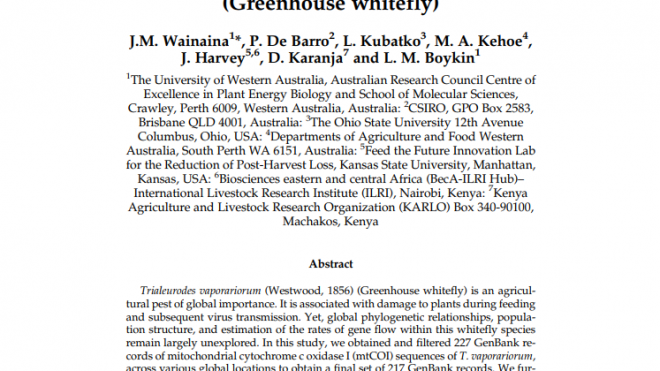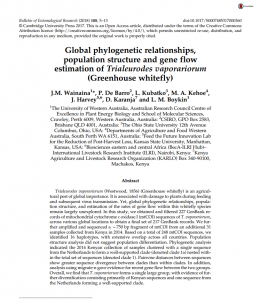Trialeurodes vaporariorum (greenhouse whitefly) is an agricultural pest of global importance. It is associated with damage to plants during feeding and subsequent virus transmission. Yet, global phylogenetic relationships, population structure, and estimation of the rates of gene flow within this whitefly species remain largely unexplored. This study obtained and filtered 227 GenBank records of mitochondrial cytochrome c oxidase I (mtCOI) sequences of T. vaporariorum, across various global locations to obtain a final set of 217 GenBank records. We further amplified and sequenced A ~750 base pair fragment of mtCOI from an additional 31 samples was amplified and sequenced. Based on a total of 248 mtCOI sequences, we identified 16 haplotypes, with extensive overlap across all countries. Population structure analysis did not suggest population differentiation. Phylogenetic analysis indicated the 2014 Kenyan collection of samples clustered with a single sequence from the Netherlands to form a well-supported clade (denoted clade 1a) nested within the total set of sequences (denoted clade 1). Pairwise distances between sequences show greater sequence divergence between clades than within clades. In addition, analysis using migrate-n gave evidence for recent gene flow between the two groups. Overall, the study found that T. vaporariorum forms a single large group, with evidence of further diversification consisting primarily of Kenyan sequences and one sequence from the Netherlands forming a well-supported clade.
Region: Kenya
Date published:
2018
Published by:
Bulletin of Entomological Research
Type of resource:
Journal article
Resource topic:
Pest control
Project/Programme: Not specific
Pest/Disease: Whitefly
Pages:
9
File type:
External link




